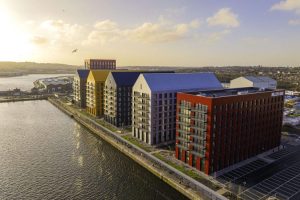Enterprising Cumbria is a recently established body working to boost economic development across the county of Cumbria, supported by the two local authorities that sit within the county – Cumberland Council and Westmorland & Furness Council. Launched in July 2024, the organisation is at the forefront of activities to drive forward Cumbria’s regional economy, working to support the objectives of the local authorities, businesses and local people.
We spoke with Isobel Brown, Programme Director, Enterprising Cumbria, about not just the work Enterprising Cumbria were overseeing, but a number of key activities across the region that were being presented at their dedicated ‘Cumbria Pavilion’ hosted at the UKREiiF real estate, property and infrastructure event in Leeds at the end of May.
Isobel – please tell us about Enterprising Cumbria?
“The role of Enterprising Cumbria has been to build on the fantastic work of the Cumbria Local Enterprise Partnership which it replaced. Essentially transferring functions from the previous body to the two unitary councils in Cumbria, the new organisation presents a milestone in the journey to providing a strong, pan-Cumbrian voice for businesses across the region. We have a remit to provide the voice of the business community and take a lead on strategic activity to keep our businesses on the front foot, and ensure that we grow our economy and the prosperity of all who live and work in our county.
“We will also deliver programmes of activity which will help us achieve our strategic aims, whether they be business support activities to help our business community innovate and grow; or skills activities to help upskill our current workforce or ensure an enthusiastic and ambitious workforce of tomorrow.”
What does Cumbria offer as a region?
“Cumbria represents a modern and entrepreneurial economy where world-leading sector strengths and an outstanding natural environment offer a unique shared prosperity for people and businesses alike. From its vibrant urban centres to its thriving rural communities, the region is home to a heritage key city, three ports, industrial urban areas, 180 miles of coastline, an enterprise zone and rural areas that boast two national parks.
“Cumbria is a £12bn economy, which brings together two of the UK’s newest, largest and most sparsely populated, and rural unitary councils. We cover nearly half of the North West’s land mass, are home to 7% of its population and 9% of businesses. Our natural assets are internationally known; our employment rate outperforms the national average, as does our rate of growing businesses. The sector strengths of the region align closely with the growth-driving sectors outlined in the Invest 2035 green paper, and the forthcoming Modern Industrial Strategy, which includes advanced manufacturing, clean energy industries, and defence.”
What sort of economic activity drives Cumbria?
“We are known as a manufacturing powerhouse, offering a broad and diverse manufacturing base. 16% of all jobs in the region are in the manufacturing sector, including high profile employers such as Pirelli and M-Sport leading in automotive innovation, James Cropper and Holmen Iggesund driving sustainable materials and packaging, and Bender UK, Anord Mardix, and Siemens advancing cutting-edge engineering solutions.
“In addition we are an economy that continues to innovate and evolve, supporting emerging specialisms in robotics, geospatial economy, AgriTech and environmental consultancy.
“We’re positioned to lead the UK in robotic and AI solutions for challenging environments, built upon our existing nuclear and defence expertise, which can be applied to other sectors such as space, mining and subsea. In fact, one of the most recent announcements has been the launch of a £4.9 million Nuclear Robotics and AI cluster, with the University of Cumbria as a key partner.”
As a region, you feature many areas of outstanding natural beauty, like the Lake District. What is your approach to protecting those areas?
“Over half of Cumbria’s landmass falls into protected landscapes, making us a key player in 30×30 – the UK’s commitment to protect and conserve a minimum of 30% of land and sea for biodiversity by 2030. We’re obviously an integral player in water security, with treatment works processing over 220m litres daily, and with over 40 green projects underway, totalling over £4.3m in nature-based projects, the region sees it’s sustainability responsibilities as an incredibly important part of its governance.”
How does Cumbria view its role within the energy sector?
“Six offshore wind farms supply 16% of the current UK’s capacity for offshore electricity, alongside onshore wind, an emerging hydrogen sector, tidal, solar and carbon capture capabilities. The region is driving forward ‘Small Modular Reactor (SMR)’ deployment across the west of the county, exemplified by TSP Engineering’s development of the NuCell, scheduled for production by 2027.
“Also, there has been a recent investment by the Department for Energy Security and Net Zero for the Barrow Green Hydrogen Project, led by Carlton Power.
“In terms of nuclear expertise, we are a world leader too. 31% of the UK’s nuclear workforce is based in Cumbria, working across key employers such as Sellafield Ltd, BAE Systems, Nuclear Decommissioning Authority, Low Level Waste Repository and the National Nuclear Laboratory. Sellafield is Europe’s largest nuclear site, driving £1.8 billion across its supply chain through its decommissioning programme.”
Another area for growth is the UK’s defence deterrent, how does Cumbria fit with this sector?
“Cumbria has a pivotal role in the Defence Nuclear Enterprise. The shipyard in Barrow, which is owned and operated by BAE Systems, is the only place in the UK with the unique skills and infrastructure needed to design and build nuclear-powered submarines. Employing approximately 14,500 people, BAE Systems is continuing to grow its workforce to support delivery of the multi-billion pound Astute, Dreadnought and SSN-AUKUS submarine programmes. A £200 million award for Team Barrow highlights our ability to harness local strengths to generate opportunities while tackling challenges related to geography, deprivation and social immobility, enabling and sustaining the Defence Nuclear Enterprise and diversification of the local economy through increased productivity.”
Returning to the region’s areas of natural beauty, how important is the visitor economy to Cumbria?
“As hosts of two iconic National Parks, and other amazing visitor destinations like Hadrian’s Wall and three National Landscapes, we strongly value our rural and agricultural economies alongside our tourism and visitor sectors. Employing around 60,000 jobs, the industries attract over 42 million visitors annually, contributing £1.2 billion in GVA. We are actually the county with the most Michelin starred restaurants outside of London.”
Can you share the impressive growth plans for Carlisle’s new Garden Village?
“As part of Government plans for a number of new Garden Villages across the UK, St Cuthbert’s in Carlisle will be by far the largest in terms of potential capacity. It represents one of the most ambitious development plans proposed in the North of England, and is currently under public consultation running until the beginning of May 2025. It includes the development of around 10,000 new homes, new employment opportunities, a wide range of community facilities, investment in green infrastructure, and includes a new Southern link road.
“Carlisle is extremely well positioned as a modern city, located just south of the Scottish borders, and within easy reach of the Lake District and Hadrian’s Wall. St Cuthbert’s will be located just south of the city, and will enjoy commanding views of the North Pennines and Lake District Fells as well as easy access to Carlisle’s regional connections.”
Please tell us about Cumbria’s dedicated pavilion and activities at UKREiiF?
“Cumbria has a busy programme over the 3 days at UKREiiF. With unparalleled access to Ministers, developers and investors, the event will showcase our region, firmly placing it on the map. The intention will be to engage decision makers and crucial stakeholders, driving a positive message forward on behalf of Enterprising Cumbria, Cumberland Council and Westmorland & Furness Council.
“As Official Partners of the event we’ll be in great company with our headline sponsors – Barrow Rising (Team Barrow), Nuclear Decommissioning Authority, Sellafield, and Nuclear Waste Services, and the themes explored over the 3 days will cover a wide range of themes and subjects. National Security and Resilience, Environmental Management, Natural Capital, Housing, Clean Energy, Economic Strategy, Devolution, Transport, Infrastructure, Ports, Regeneration and Sustainability – there are many more pinch points we’ll be covering at our dedicated site.”
Please join us as Official Partners at our Enterprising Cumbria Pavilion – Stand 30 – at UKREiiF in May.
Find out more!
[email protected]
[email protected]
enterprisingcumbria.org.uk
cumberland.gov.uk
westmorlandandfurness.gov.uk
The post Enterprising Cumbria – going for growth appeared first on Business Connect Magazine.











